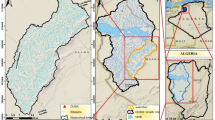Abstract
Assessment of damages due to fire, drought, flood, land slide, etc., using hyperspectral images from Hyperion, AVIRIS or HyspIRI has challenging issues. The effects of different illumination, atmospheric conditions and varying sensor/target viewing geometries are some of these challenges. A common approach for target detection is to apply atmospheric correction algorithms to the radiance image data cube and then search within the atmospherically corrected image cube for the target reflectance signature of interest. One major issue with the above approach is that it is computationally demanding. In this paper, instead of applying atmospheric correction to the raw radiance data, we generate radiance profiles of burn scar for the observed atmospheric and illumination conditions at the time of the hyperspectral image data collection and form a radiance profile library using a nonlinear analytical model for radiative transfer and MODTRAN. The target detection has been performed by a spectral similarity technique which takes into consideration multiple radiance profile variants of the target of interest. The effectiveness of the radiance domain-based target detection approach on reducing the computation time has been demonstrated on burn scar detection using airborne AVIRIS image data.








Similar content being viewed by others

References
Ientilucci, E.J., Matteoli, S., Kerekes, J.P.: Tracking of vehicles across multiple radiance and reflectance hyperspectral datasets. In: Shen, S.S., Lewis, P.E. (eds.) Proceedings of SPIE 7334, Algorithms and Technologies for Multispectral, Hyperspectral, and Ultraspectral Imagery XV, vol. 7334 (2009). doi:10.1117/12.820348
Matteoli, S., Ientilucci, E.J., Kerekes, J.P.: Operational and performance considerations of radiative-transfer modeling in hyperspectral target detection. IEEE Trans. Geosci. Remote Sens. 49(4), 1343–1355 (2011)
Adler-Golden, S., et al.: FLAASH, A MODTRAN4 atmospheric correction package for hyperspectral data retrievals and simulations. In: Airborne Visible/Infrared Imaging Spectrometer (AVIRIS), 1998 Workshop Proceedings
Kolodner, M.A.: “An Automated Target Detection System for Hyperspectral Imaging Sensors,” Johns Hopkins APL Technical Digest, Volume 27, Number 3 (2007)
Mariano, A.V., Grossmann, J.M.: Hyperspectral material identification on radiance data using single-atmosphere or multiple-atmosphere modeling. Appl. Remote Sens. 4(1), 043563 (2010). doi:10.1117/1.3526717
Toulouse, T., et al.: Automatic fire pixel detection using image processing: a comparative analysis of rule-based and machine learning-based methods. Signal Image Video Process. 10(4), 647–654 (2016)
Liu, Z.-G., Yang, Y., Ji, X.-H.: Flame detection algorithm based on a saliency detection technique and the uniform local binary pattern in the YCbCr color space. Signal Image Video Process. 10(2), 277–284 (2016)
Günay, O., et al.: Fire detection in video using LMS based active learning. Fire Technol. 46(3), 551–577 (2010)
San-Miguel-Ayanz, J., Ravail, N.: Active fire detection for fire emergency management: potential and limitations for the operational use of remote sensing. Nat. Hazards 35(3), 361–376 (2005)
Roy, D.P., Lewis, P.E., Justice, C.O.: Burned area mapping using multi-temporal moderate spatial resolution data—a bi-directional reflectance model-based expectation approach. Remote Sens. Environ. 83(1), 263–286 (2002)
Li, R., et al.: A technique for detecting burn scars using MODIS data. IEEE Trans. Geosci. Remote Sens. 42(6), 1300–1308 (2004)
Wang, J., et al.: Burn scar identification based on recognition of fire spots. In: Geoscience and Remote Sensing (IITA-GRS), 2010 Second IITA International Conference on, vol. 2. IEEE, 2010
Kwan, C., Ayhan, B., Chen, G., Wang, J., Ji, B., Chang, C.-I.: A novel approach for spectral unmixing, classification, and concentration estimation of chemical and biological agents. IEEE Trans. Geosci. Remote Sens. 44, 409–419 (2006)
AVIRIS website. http://aviris.jpl.nasa.gov/
http://modisfire.umd.edu/Documents/MODIS_Burned_Area_Collection5_User_Guide_2.0.pdf
Bernstein, L.S., et al.: Quick atmospheric correction code: algorithm description and recent upgrades. Opt. Eng. 51(11), 111719 (2012)
Jin, X., et al.: A comparative study of target detection algorithms for hyperspectral imagery. In: Algorithms and Technologies for Multispectral, Hyperspectral and Ultraspectral Imagery, Proceedings of SPIE, vol. 7334 (2009)
Manolakis, D., et al.: Is there a best hyperspectral detection algorithm. In: Algorithms and Technologies for Multispectral, Hyperspectral and Ultraspectral Imagery, Proceedings of SPIE, vol. 7334 (2009)
Acknowledgments
This research was supported by NASA under Contract Number NNX14CG28P. Any opinions, findings and conclusions or recommendations expressed in this material are those of the author(s) and do not necessarily reflect the views of NASA.
Author information
Authors and Affiliations
Corresponding author
Rights and permissions
About this article
Cite this article
Ayhan, B., Kwan, C. On the use of radiance domain for burn scar detection under varying atmospheric illumination conditions and viewing geometry. SIViP 11, 605–612 (2017). https://doi.org/10.1007/s11760-016-1000-8
Received:
Revised:
Accepted:
Published:
Issue Date:
DOI: https://doi.org/10.1007/s11760-016-1000-8



